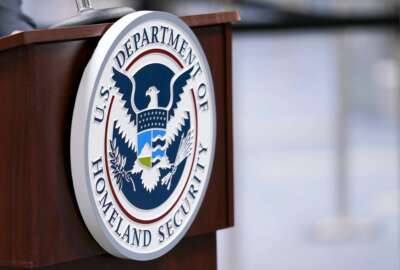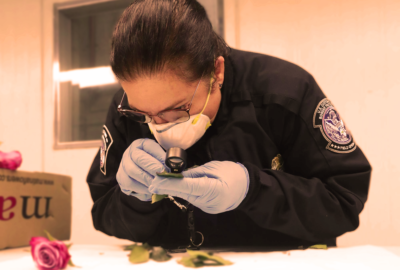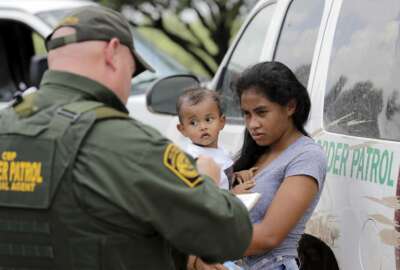
30-by-30: CBP shoots for a much larger female workforce
Customs and Border Protection has a diversity goal. The agency wants 30% of its workforce to be women by 2030.
Best listening experience is on Chrome, Firefox or Safari. Subscribe to Federal Drive’s daily audio interviews on Apple Podcasts or PodcastOne.
Customs and Border Protection has a diversity goal. The agency wants 30% of its workforce to be women by 2030. The Federal Drive with Tom Temin took a look at the so-called, “30-by-30 initiative,” with CBP’s assistant commissioner for the Office of Human Resources Management, Andrea Bright.
Interview transcript:
Tom Temin: And I take it that the law enforcement part of CBP is not 30% women at this point, is it? Where do you hover so far?
Andrea Bright: Currently, for our new hires — and we’re really focusing on our new hires as we bring new classes of recruits into our law enforcement workforce — currently, in FY 22, about 19% of our new hires were female in the law enforcement arena. And that was about a 3% increase over FY 21. But we are looking to bring that percentage up to 30% of our new recruits by 2030.
Tom Temin: Got it. And how many people a year are you bringing in for law enforcement, roughly?
Andrea Bright: It really varies each year; our goal is to at least keep up with attrition. And sometimes we have additional hires, depending on the year.
Tom Temin: But I mean, it’s several thousand, that order of magnitude? Because you have an end strength that is determined by the budget by Congress. And so you’ve got to maintain that.
Andrea Bright: Exactly. Yeah. And at CBP, we have a variety of law enforcement positions. We have Border Patrol agents, we also have our Customs and Border Protection officers who people probably meet as they’re coming back into the country and going through customs. And then we have air interdiction agents, who are pilots, who are law enforcement officers and marine interdiction agents, who are also law enforcement officers. So we have a variety of positions, as well as some investigators.
Tom Temin: And those are considered part of the law enforcement piece of it. Got it. What is that total law enforcement population, roughly, if you add them all up?
Andrea Bright: It is about 80% of our population. So we have about 60,000 employees. So our total frontline employees are 46,000 of those.
Tom Temin: Okay, yeah. So that’s a pretty good police force, basically, you’re trying to keep up with.
Andrea Bright: It is. CBP is actually the largest law enforcement agency in the United States.
Tom Temin: All right. And so what is the selling proposition to get more women to come in to CBP? And let’s talk about what level, career-wise — beginner, mid-career, whatever — that you’re looking for. But what makes CBP attractive do you think?
Andrea Bright: At CBP, it really is about the purpose to defend our and protect our nation’s borders. And we also facilitate legal trade and travel into the United States. For our workforce, it’s about serving public, serving the nation, going beyond, sort of our theme of taking on adversity and demonstrating courage and compassion.
Tom Temin: All right, and for women then would come in to law enforcement, you would expect them to be if necessary, and if that’s their desire, right on the front lines, say, of border protection?
Andrea Bright: Exactly. They will be either on our borders, if they are serving as a border patrol agent, actually between ports of entry or if they’re a Customs and Border Protection officer then they serve at ports of entry, like airports or our land ports of entry.
Tom Temin: All right. And do you have any particular job hiring flexibilities or programs like that that would make it easier to get more women in? What is it OPM says, I think there’s 124 job hiring flexibilities that nobody uses.
Andrea Bright: There are a lot of different flexibilities. One of the areas that CBP is particularly proud of is that we over the years named as one of the best employers for veterans. And so, in particular, as people are transitioning out of the military, we find that CBP is a great opportunity for veterans who want to continue to serve their nation.
Tom Temin: And many of the municipal police departments around the country are reporting problems recruiting people to become police officers. Do you share that challenge or is federal law enforcement service so different from being a policeman in a city that really doesn’t wash over that way?
Andrea Bright: It really is a challenge. There is a challenge nationally, in terms of hiring law enforcement officers, but we think that CBP has unique opportunities that should be attractive to a wide variety of folks. This 30 by 30 initiative is actually a national initiative that includes about 240 different law enforcement organizations across the country, ranging from university police departments to LAPD, NYPD, and the federal government, the Marshals Service and us at CBP. So a lot of agencies are really teaming up to address this challenge of bringing more women into the opportunity of law enforcement.
Tom Temin: We’re speaking with Andrea Bright, she is the assistant commissioner for the Office of Human Resources Management at US Customs and Border Protection. And are you looking for people — well you mentioned veterans, of course those would be tend to be a little bit older because they’ve done their military service, so they could be at least three or four years older than the average college graduate, I guess — but what about collegiate recruiting and trying to get people early in their careers? Is that part of the program?
Andrea Bright: It is; we do a lot of recruiting at universities. We also, as I said, are recruiting veterans. We have a lot of webinars, job fairs, and individuals who are looking for law enforcement jobs may even see some of our popup notifications if they’re on Pinterest or on LinkedIn. We really are looking for a wide variety of folks who are just interested in joining us and serving our mission.
Tom Temin: That whole idea of recruitment by any organization has really taken on a social media component, hasn’t it, in recent years, to what I find to be an astonishing degree.
Andrea Bright: It has definitely, I think it was starting before COVID began. But with the cancellation of a lot of in person job fairs during COVID over the last few years, organizations including CBP increased our online and webinar type of presence, and we’ve had a lot of individuals who are really responding that way. I think it’s great for people who might not be local where we happen to be recruiting. It enables us to expand to the entire nation.
Tom Temin: And for those that are early career, are you focusing on criminal justice majors? Or is it wider than that?
Andrea Bright: It is wider than that. Criminal justice majors, though, are probably more likely to be interested in our types of jobs, because they’ve already expressed an interest in law enforcement. But we are much broader in terms of who we’re recruiting. We also have a position that I would mention, as a border patrol processing coordinator. Those are individuals who are, it’s sort of a lead-in position for individuals, where they may start as a processing coordinator, and after a year to transition into being a border patrol agent, or a Customs and Border Protection officer. So we’re looking at as many ways as we can to really get people excited about the opportunities that we have.
Tom Temin: And what kind of training is required from the point at which you say, yes, you’re right for this job, come on into the agency, until you deploy them in a law enforcement situation?
Andrea Bright: We provide very structured training. It includes things like the law, obviously, there’s also physical training, law enforcement types of training. So it is very extensive, to make sure that individuals are fully prepared for the job before they are on site and actually asked to start performing.
Tom Temin: Do you get to drive a car backwards really fast?
Andrea Bright: I don’t know if they drive cars backwards.
Tom Temin: That’s the FBI training, but that may not be for everyone. And I mean, some of your officers in some places are horse-mounted too, correct?
Andrea Bright: They are, yeah. We have special units. In some cases, they’re horse mounted, or on ATVs, even on what we call riverine units on boats along the border rivers. So there are a variety of, as I said, exciting opportunities to do different types of work at CBP.
Tom Temin: And for better or for worse, the border is in the news. And everyone’s got their opinion about this or that. Does that amount of scrutiny, do you think, help people want to become Border Patrol agents? Or does it want to keep them away because of all the controversy they see on cable TV?
Andrea Bright: I think that individuals who are seeking out positions at CBP are really excited about the mission and they’re individuals who are committed to serving their community really.
Tom Temin: All right, well, young ladies out there that want to do this. This is the place to turn.
Copyright © 2025 Federal News Network. All rights reserved. This website is not intended for users located within the European Economic Area.
Tom Temin is host of the Federal Drive and has been providing insight on federal technology and management issues for more than 30 years.
Follow @tteminWFED
Related Stories





